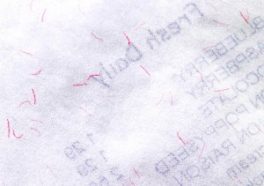What’s in your receipt?
Here's one way to avoid BPA this holiday season

Appleton Paper, a company in Wisconsin, makes the kind of paper used for cash-register receipts. Starting in the first two weeks of November, the company’s receipt paper comes with something new. Tiny flakes of red fibers will show up on the back. Next time you come across a receipt, flip it over and see whether you can see red.
If you do, rest easy — because Appleton’s receipts do not contain bisphenol A (BPA), a chemical that has been in the news. Recent studies show BPA could be hazardous to your health. BPA is called a hormone disruptor. That means it enters the body and acts like a hormone, a chemical that can control body processes. When BPA acts like hormones, the body’s real hormones may have trouble doing their job.
Studies have turned up a link between BPA and heart disease. Exposure to the chemical might also make a person more likely to develop diseases such as diabetes, other data show. In roundworms, which are often used in the laboratory as a model for humans, BPA interferes with reproduction. That might mean bad news for human reproduction, too.
In three separate studies last year, conducted all over the world, researchers discovered BPA in cash register and ATM receipts. Some studies showed that the BPA rubs off easily onto a person’s hand. A recent report from the French government says this BPA is quickly absorbed into the skin and then into the bloodstream.
“I won’t touch receipts now,” Frederick vom Saal told Science News. He is a scientist at the University of Missouri in Columbia. He investigated store receipts as part of a study by the nonprofit Environmental Working Group, based in Washington, D.C.. Vom Saal is now working on a study that looks not only at how BPA travels from receipts into the skin, but also at how much of that BPA later turns up in a person’s urine or blood.
A recent study of pregnant American women found that cashiers, who work with receipts all day, have higher levels of BPA in their blood and urine. Since BPA passes so easily into the body, it may also pass easily into the fetus. And that might mean that a mother’s BPA exposure could be hazardous to her children.
Receipts are not the only source of BPA — far from it. BPA is used in the production of some plastics. BPA can travel from the plastic into the body. That BPA becomes more mobile when the plastic is heated — in a dishwasher or microwave, for example — or when it is scratched.
In addition to water bottles and other containers, plastic shows up in places you wouldn’t expect: bike helmets, telephones, computers. As a quick example, consider a typical automobile: plastic is used in the seats, dashboard, parts of the body and some engine parts.
BPA is in receipts and in plastic, and a recent study turned up BPA in yet another alarming source: food. In a recent study, scientists in Texas tested 31 types of canned foods or foods packaged in plastic. They discovered measurable amounts of BPA in 60 percent of the food products.
The Environmental Protection Agency recommends people consume no more than 50 micrograms of BPA per kilogram (2.2 pounds) of body weight. The food-based BPA measured by the Texas scientists is far below that guideline.
Scientists are still trying to determine both the real risks of BPA, and how much of the chemical is too much. To be on the safe side, check your receipts — and your plastic.
POWER WORDS (from the Yahoo! Kids Dictionary and the National Institutes of Health)
plasticizer Any of various substances added to plastics or other materials to make or keep them soft or pliable.
plastic Any of various organic compounds produced by polymerization, and capable of being molded, extruded, cast into various shapes and films, or drawn into filaments used as textile fibers.
BPA A chemical produced in large quantities for use primarily in the production of plastics.
hormone A substance produced by one tissue that travels through the bloodstream to another tissue to effect physiological activity, such as growth or metabolism.







